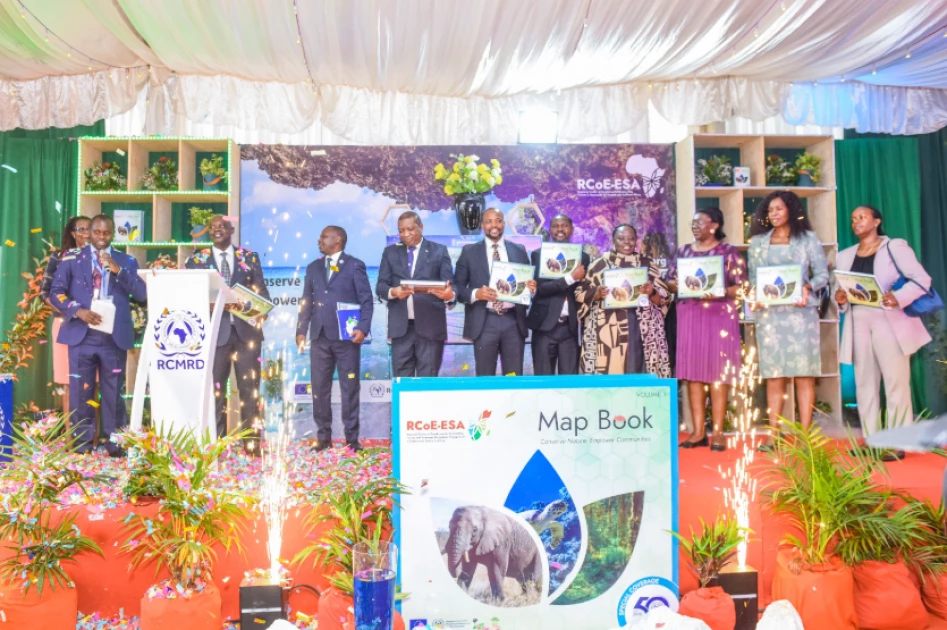Eastern, Southern Africa fall behind on biodiversity goals

Deus Gumba, Malawi’s Minister of Lands, officially launched the RCoE Map Book during the RCMRD@50 celebrations. He was joined by key dignitaries, including Kenya’s Principal Secretary for Lands Nixon Korir, and RCMRD Director General Dr. Emmanuel Nkurunziza. The publication highlights spatial data and insights on biodiversity, protected areas, and conservation efforts across 24 countries in Eastern and Southern Africa

Audio By Vocalize
The Convention on Biological Diversity (CBD) parties have been
reminded to demonstrate full commitment to the treaty to advance the
implementation of the Global Biodiversity Framework.
The Regional Centre of Excellence for Biodiversity, Forests,
and Seascape Ecosystems Management in Eastern and Southern Africa (RCoE-ESA),
hosted by the Regional Centre for Mapping of Resources for Development (RCMRD),
early in the week launched their publication that highlights spatial data and
insights on biodiversity, protected areas, and conservation efforts across 24
countries, revealing some worrying status of commitments to forests and
biodiversity restoration agenda.
As at 2025, the Map book reveals that in Eastern and Southern
Africa region, only two countries - Uganda and Tanzania - have so far complied
in alignment with the Kunming-Montreal Global Biodiversity Framework on
submission of the National Biodiversity Strategic Action Plans (NBSAPs).
This coming several months after the biodiversity COP16 in
2024, and ahead of the February 2026 submission deadline before the next
biodiversity COP17 scheduled to be held later the same year in Yerevan,
Armenia.
Across Eastern and Southern Africa, 22 nations are still in
the process of preparing or have not yet submitted their reports.
The map serves as a call to action for countries yet to meet
their obligations, emphasizing the urgency of timely submissions ahead of the
deadline.
Timely and inclusive NBSAP submissions are critical to
ensuring regional and global progress toward halting biodiversity loss.
Speaking during the Map Book launch, Dr. Emmanuel Nkurunziza,
Director General, RCMRD, emphasized that Geospatial science is a powerful tool
for conservation and sustainable development.
“Through data-driven planning and ecosystem mapping, we can
restore biodiversity-rich forests, seascapes, wetlands, and other vital
ecosystems. This Map Book is a call to action and a key tool for strategic
planning across our region,” he added.
The RCoE-ESA Map Book also shows how the 24 countries
including Kenya are progressing toward Target 3 of the Global Biodiversity
Framework, which calls for 30% of the earth’s land and sea to be conserved.
The map also displays Kenya’s statistics on protected and conserved
areas, revealing 41 areas, covering 82,185 square kilometers, equivalent to
13.97% of the country’s terrestrial area and 0.59% marine coverage.
The 41 protected areas have undergone Management Effectiveness
Assessments, revealing that a total of 11.63% of Kenya’s land area has been
conserved and to meet Target 3 of the Kunming-Montreal Global Biodiversity
Framework (KMGBF), which calls for 30% protection, Kenya therefore still needs to
cover an additional 18.37% of its territory. The concern remains how to arrive
there.
Notwithstanding the data, as pressures such as climate change,
habitat degradation, and unsustainable land use intensify, stakeholders
maintain that the need for informed, data-driven policy interventions has never
been greater. The Map book is a new tool that is expected to guide conservation
priorities, policy formulation, and sustainable land and sea use planning.


Leave a Comment